The Scientific Research Behind Cane Sugar Processing: Exactly How Sweetness is Improved
The Scientific Research Behind Cane Sugar Processing: Exactly How Sweetness is Improved
Blog Article
Discovering the Comprehensive Tips Included in Walking Stick Sugar Processing From Gathering to Improvement
The procedure of walking stick sugar production encompasses a series of complex actions, beginning with the mindful harvesting of sugarcane and culminating in the refinement stages that ensure the last product fulfills sector standards. Each stage, from the removal of juice to the purification and condensation processes, plays a vital duty in determining the high quality and character of the sugar. Recognizing these stages not only highlights the complexity of sugar manufacturing but likewise raises important inquiries concerning performance, sustainability, and development in the sector. What implications do these variables have for future practices?
Collecting Sugarcane
Gathering sugarcane is a critical action in the walking cane sugar processing chain, as it directly affects the high quality and return of the end product. Proper timing and techniques are important throughout this phase to make sure optimal sugar material and decrease losses. Commonly, sugarcane is collected when it reaches maturation, generally 12 to 18 months after planting, defined by a high sucrose focus.

Post-harvest, the sugarcane must be processed swiftly to protect against sucrose destruction. Ideally, harvested walking stick needs to be moved to refining facilities within 1 day to maintain sugar top quality. Consequently, efficient logistical planning is critical to preserve the integrity of the gathered crop throughout the supply chain.
Extraction Refine

The crushed cane undergoes a collection of pushing procedures to maximize juice recuperation. Usually, hot water is splashed onto the smashed cane, creating a countercurrent circulation that assists dissolve the sugar while additionally helping in the extraction process. The juice gathered from this operation contains not only sugar however likewise numerous natural compounds and impurities.

To boost removal effectiveness, some centers might employ diffusion methods, where the sugarcane is taken in hot water, allowing the soluble sugars to diffuse into the fluid. The resulting juice, rich in sucrose, is then guided to succeeding processing stages, laying the foundation for purification and refinement. The removal procedure is hence critical in establishing the quality and return of the last sugar item.
Purification Techniques
The purification strategies used in cane sugar handling are crucial for transforming the raw juice right into a top quality sugar product. These techniques mostly aim to eliminate pollutants, such as soil, plant materials, and not natural compounds, which can detrimentally affect the end product's flavor and color.
Among the most typical purification methods is clarification. This procedure entails including lime and warm to the raw juice, which helps with the coagulation of contaminations. The resulting precipitate is after that gotten rid of with sedimentation or filtration, producing a more clear juice. Furthermore, making use of phosphoric acid can enhance the information process by further binding contaminations.
Another considerable method is carbonatation, where carbon dioxide is introduced to the cleared up juice. This response produces calcium carbonate, which captures remaining pollutants and advertises their removal.
Additionally, turned on carbon treatment may be related to adsorb any type of remaining colorants and organic contaminations, ensuring Resources a more polished product. The combination of these techniques effectively prepares the sugar juice for succeeding action in the refining procedure, setting the phase for the production of premium cane sugar.
Crystallization Techniques
After the filtration stage, the following important step in walking cane sugar handling involves crystallization methods, which play a pivotal duty in transforming the cleared up juice right into strong sugar. This process normally employs two key techniques: spontaneous formation and controlled condensation.
In spontaneous formation, supersaturated sugar options are allowed to cool down naturally, leading to the formation of sugar crystals over time. This technique allows for the uniform growth of sugar crystals and greater pureness.
Throughout formation, the made clear juice is focused with dissipation, enhancing its sugar content till it gets to supersaturation. Once this point is achieved, either technique can help with the condensation procedure. Cane Sugar Processing. The resultant sugar crystals are after that separated from the remaining syrup through centrifugation
Inevitably, the option of crystallization technique affects the top quality, dimension, and pureness of the last sugar product, making this action crucial in the general walking stick sugar processing procedure.
Improvement and Packaging
How can the pureness and top quality of cane sugar be additionally boosted after crystallization? The refinement process plays a vital function in achieving high-quality cane sugar. Adhering to crystallization, sugar undergoes a comprehensive washing to get rid of pollutants and residual molasses. This is generally achieved using warm water or vapor, which assists liquify and draw out unwanted elements while maintaining the sugar crystals.
Next, the sugar is subjected to a procedure called centrifugation, where it is spun at broadband to separate the detoxified sugar crystals from the go to my site continuing to be fluid. After centrifugation, the sugar is typically further refined with a method called carbonization or phosphatation, which uses turned on carbon or phosphoric acid to get rid of color and off-flavors.
When improved, the sugar is dried to accomplish the preferred wetness content, making certain that it remains steady throughout storage and transportation. The last action includes packaging the polished sugar in moisture-proof and closed containers to preserve its quality and prevent contamination. Cane Sugar Processing. Correct product packaging not just prolongs life span however also helps with easy handling and circulation, making sure that consumers obtain sugar that satisfies the greatest standards of purity and top quality
Verdict
The thorough steps associated with walking cane sugar processing, from the precise harvesting of sugarcane to the complex refinement and product packaging stages, underscore the value of each stage in making certain premium sugar manufacturing. Optimum harvesting methods, efficient removal techniques, and strenuous filtration processes jointly add to the last item's pureness and stability. The condensation and subsequent packaging practices better boost the stability and life span of the sugar, highlighting the complexity and precision fundamental in this necessary agricultural sector.
The procedure of walking stick sugar production incorporates a series of complex actions, beginning with the cautious harvesting of sugarcane and culminating in the improvement stages that make certain the final product satisfies market standards. Preferably, harvested cane must be transported to refining centers within 24 hours to protect sugar top quality.In spontaneous formation, supersaturated sugar options are enabled to cool normally, leading to the development of sugar crystals over time - Cane Sugar Processing. The improvement process plays an essential function in accomplishing high-quality walking cane sugar.The detailed actions involved in walking cane sugar handling, from the careful harvesting of sugarcane to the elaborate refinement and packaging phases, underscore the relevance of each stage in making directory certain top notch sugar production
Report this page